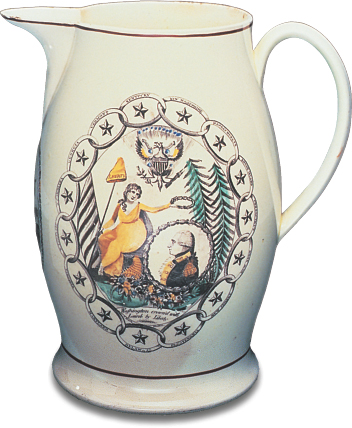Washington Inaugurates the Government.
Printed Page 219 Chapter Chronology
Washington Inaugurates the Government. George Washington was elected president in February 1789 by a unanimous vote of the electoral college. (John Adams got just half as many votes; he became vice president, but his pride was wounded.) Washington perfectly embodied the republican ideal of disinterested, public-spirited leadership. Indeed, he cultivated that image through astute ceremonies such as the dramatic surrender of his sword to the Continental Congress at the end of the war, symbolizing the subservience of military power to the law.

Once in office, Washington calculated his moves, knowing that every step set a precedent and that any misstep could be dangerous for the fragile government. Congress debated a title for Washington, ranging from "His Highness" to "His Majesty, the President"; Washington favored "His High Mightiness." But in the end, republican simplicity prevailed. The final title was simply "President of the United States of America," and the established form of address became "Mr. President," a subdued yet dignified title reserved for property-owning white males.
Washington's genius in establishing the presidency lay in his capacity for implanting his own reputation for integrity into the office itself. In the political language of the day, he was "virtuous," meaning that he took pains to elevate the public good over private interest and projected honesty and honor over ambition. He remained aloof, resolute, and dignified, to the point of appearing wooden at times. He encouraged pomp and ceremony to create respect for the office, traveling with six horses to pull his coach, hosting formal balls, and surrounding himself with uniformed servants. He even held weekly "levees," as European monarchs did, hour-long audiences granted to distinguished visitors (including women), at which Washington appeared attired in black velvet, with a feathered hat and a polished sword. The president and his guests bowed, avoiding the egalitarian familiarity of a handshake. But he always managed, perhaps just barely, to avoid the extreme of royal splendor.
Washington chose talented and experienced men to preside over the newly created Departments of War, Treasury, and State. For the Department of War, Washington selected General Henry Knox, former secretary of war in the confederation government. For the Treasury — an especially tough job in view of revenue conflicts during the confederation (see chapter 8) — the president appointed Alexander Hamilton, known for his general brilliance and financial astuteness. To lead the State Department, which handled foreign policy, Washington chose Thomas Jefferson, a master diplomat and the current minister to France. For attorney general, Washington picked Edmund Randolph, a Virginian who had attended the constitutional convention but who had turned Antifederalist during ratification. For chief justice of the Supreme Court, Washington designated John Jay, a New York lawyer who had helped to write The Federalist Papers.
Soon Washington began to hold regular meetings with these men, thereby establishing the precedent of a presidential cabinet. No one anticipated that two decades of party turbulence would emerge from the brilliant but explosive mix of Washington's first cabinet.